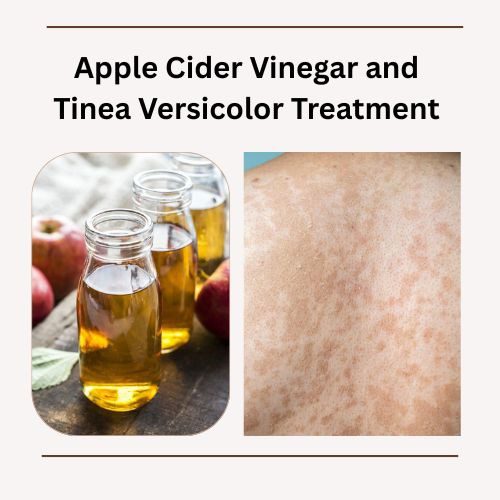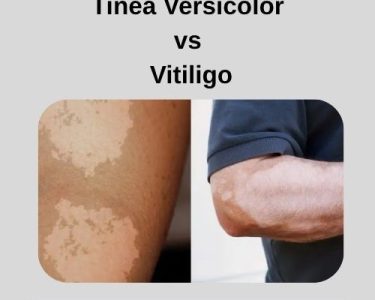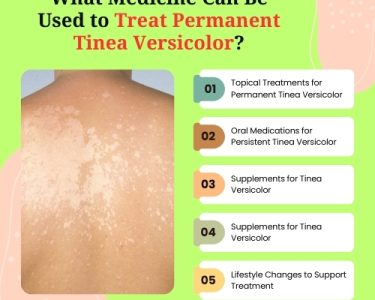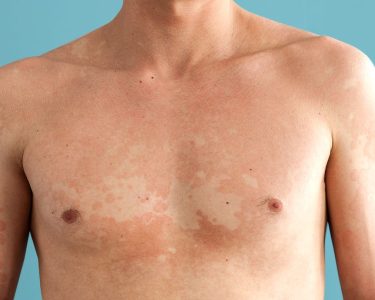Skin conditions can affect not only your appearance but also your confidence. Among the many fungal infections that people face, Tinea Versicolor stands out as a particularly stubborn one. This condition, caused by the overgrowth of yeast on the skin, often leads to uneven patches that can be lighter or darker than your natural skin tone.
While conventional treatments such as antifungal creams and shampoos are common, Natural Remedies for Tinea Versicolor are increasingly gaining popularity. One remedy that has garnered attention for its antifungal properties is apple cider vinegar (ACV). In this article, we’ll explore everything you need to know about Apple Cider Vinegar and Tinea Versicolor—from its effectiveness and how to use it safely, to additional tips for preventing recurrence.
What Is Tinea Versicolor?
Tinea Versicolor, also known as Pityriasis Versicolor, is a fungal skin infection caused by the yeast Malassezia. This yeast is naturally found on the skin, but under certain conditions—such as heat, humidity, or oily skin—it can multiply excessively. When that happens, it disrupts the normal pigmentation of the skin, resulting in discolored patches.
Common Symptoms Include:
- Irregular patches that are lighter or darker than your normal skin tone
- Mild itching, especially in hot weather
- Fine, scaly texture on affected areas
- Patches often found on the chest, back, neck, and upper arms
Although Tinea Versicolor is not contagious or dangerous, it can be persistent and cosmetically bothersome.
Why Consider Apple Cider Vinegar for Tinea Versicolor?
Apple cider vinegar has long been used as a home remedy for various skin conditions, thanks to its antimicrobial, antifungal, and pH-balancing properties. When it comes to Tinea Versicolor, apple cider vinegar may help restore the skin’s natural balance and inhibit the growth of Malassezia yeast.
Here are some reasons why apple cider vinegar is considered beneficial:
1. Antifungal Properties
ACV contains acetic acid, which has been shown to inhibit the growth of fungi and bacteria. This makes it a potential natural antifungal agent that can help reduce the yeast responsible for Tinea Versicolor.
2. Balances Skin pH
Healthy skin typically has a slightly acidic pH, which helps keep microorganisms under control. When yeast overgrows, the skin’s pH may become imbalanced. Apple cider vinegar can help restore the natural acidity of the skin, discouraging further fungal proliferation.
3. Natural Exfoliant
The mild acidity in ACV helps remove dead skin cells and excess oil, allowing new skin to regenerate. This exfoliating action can improve the appearance of discolored patches caused by Tinea Versicolor.
4. Reduces Itching and Irritation
For some sufferers, Tinea Versicolor causes mild itching or irritation. Apple cider vinegar’s soothing and anti-inflammatory properties can help calm the skin and reduce discomfort.
Scientific Evidence Behind Apple Cider Vinegar’s Antifungal Power
While there isn’t a wealth of large-scale clinical studies specifically examining Apple Cider Vinegar and Tinea Versicolor, several studies support ACV’s antifungal effects.
- A study published in the Journal of Food Science found that acetic acid effectively inhibits fungal growth, including species related to Candida and other yeast-like organisms.
- Another report highlighted that apple cider vinegar helps eliminate dermatophytes, fungi responsible for various skin infections.
Although more research is needed to confirm its effectiveness against Malassezia specifically, the existing evidence suggests that ACV could complement conventional treatments.
How to Use Apple Cider Vinegar for Tinea Versicolor
If you’re considering trying apple cider vinegar for Tinea Versicolor, it’s crucial to use it correctly to avoid skin irritation. Below are several methods to incorporate ACV safely into your skincare routine.
1. Apple Cider Vinegar Diluted Solution (Topical Treatment)
What You’ll Need:
- Raw, unfiltered apple cider vinegar (with “the mother”)
- Water
- Cotton ball or clean cloth
Instructions:
- Mix one part apple cider vinegar with one part water (1:1 ratio).
- Dip a cotton ball into the solution and apply it gently to the affected areas.
- Leave it on for 15–20 minutes, then rinse with lukewarm water.
- Pat dry and repeat once or twice daily.
Tip:
If you experience a burning sensation, further dilute the solution by adding more water (2:1 or 3:1 ratio).
2. Apple Cider Vinegar Bath
This method is ideal if large areas of your body are affected.
What You’ll Need:
- 2 cups of apple cider vinegar
- A bathtub filled with warm water
Instructions:
- Add apple cider vinegar to your bathwater.
- Soak in the tub for 15–20 minutes.
- Gently pat your skin dry after bathing—avoid harsh rubbing.
Frequency:
Use this bath three times per week until improvement is seen.
3. Apple Cider Vinegar Spray
A spray is convenient for daily use, especially for hard-to-reach areas like your back.
What You’ll Need:
- 1 cup of apple cider vinegar
- 1 cup of water
- Spray bottle
Instructions:
- Mix equal parts ACV and water in the spray bottle.
- Spray the affected areas once daily after showering.
- Allow it to air dry before dressing.
4. Apple Cider Vinegar and Tea Tree Oil Blend
Tea tree oil is another natural antifungal agent. Combining it with ACV can enhance the overall antifungal effect.
What You’ll Need:
- 1 tablespoon apple cider vinegar
- 2–3 drops of tea tree essential oil
- 2 tablespoons water
Instructions:
- Mix all ingredients thoroughly.
- Apply with a cotton ball or spray on the affected area.
- Leave for 15–20 minutes before rinsing.
Caution:
Always perform a patch test first, as essential oils can cause irritation on sensitive skin.
Additional Natural Remedies to Support ACV Treatment
While apple cider vinegar can be beneficial, combining it with other natural and lifestyle remedies can improve outcomes and prevent recurrence.
1. Maintain Skin Hygiene
Wash daily using an antifungal soap or body wash containing selenium sulfide or ketoconazole. Keeping your skin clean helps prevent yeast buildup.
2. Avoid Oily Products
Since Malassezia feeds on oils, avoid using heavy lotions or greasy sunscreens that can worsen the infection.
3. Sun Protection
After treatment, discolored patches may persist for weeks or months even after the fungus is gone. Use broad-spectrum sunscreen to prevent further uneven pigmentation.
4. Probiotics
Adding probiotic supplements or consuming yogurt with live cultures may help balance the skin’s microbiome, reducing yeast overgrowth.
5. Wear Breathable Clothing
Choose cotton or moisture-wicking fabrics that allow your skin to breathe and prevent excess sweating, which can trigger fungal growth.
Precautions When Using Apple Cider Vinegar
While apple cider vinegar is natural, it is still acidic and potent, so misuse can lead to irritation or burns. Follow these safety tips:
- Always Dilute ACV:
Never apply undiluted apple cider vinegar directly to your skin, as it may cause stinging, redness, or chemical burns. - Do a Patch Test:
Before using ACV widely on your skin, test a small area on your forearm. Wait 24 hours to ensure no allergic reaction occurs. - Avoid Broken Skin:
Do not apply apple cider vinegar to open wounds or severely inflamed skin. - Limit Use Around Eyes and Genitals:
ACV is too acidic for sensitive areas, so avoid using it near the eyes or genital region. - Consult a Dermatologist:
If your symptoms persist for more than two weeks or worsen, seek professional medical advice. You may need a prescription antifungal treatment.
When to See a Doctor
Although natural remedies like apple cider vinegar can be helpful, Tinea Versicolor sometimes requires stronger interventions. See a doctor if you notice:
- The infection spreads rapidly or covers a large area
- Itching becomes severe or painful
- Discoloration doesn’t improve after several weeks of treatment
- You experience recurring outbreaks despite good hygiene
Your dermatologist may recommend topical antifungal creams, oral antifungal medications, or medicated shampoos containing selenium sulfide, zinc pyrithione, or ketoconazole.
Preventing Recurrence of Tinea Versicolor
Tinea Versicolor is notorious for recurring, especially in warm and humid environments. Preventive care is key to long-term management. Here’s what you can do:
1. Use Medicated Shampoos Weekly
Even after recovery, apply antifungal shampoos once a week on your skin for maintenance.
2. Keep Your Skin Dry
Moisture promotes yeast growth. Always dry your skin thoroughly after showers or exercise.
3. Manage Sweating
Shower promptly after sweating, and try to stay cool in hot weather.
4. Strengthen Immune Function
A strong immune system can help keep yeast levels balanced. Eat a nutrient-rich diet with plenty of antioxidants, zinc, and vitamins A, C, and E.
5. Limit Sugar Intake
Fungi and yeast thrive on sugar, so reducing sugar in your diet can help prevent recurrence.
Apple Cider Vinegar vs. Conventional Treatments
Let’s compare the benefits and limitations of apple cider vinegar with standard antifungal treatments.
| Aspect | Apple Cider Vinegar | Conventional Treatments |
| Type | Natural home remedy | Medical creams, shampoos, or oral antifungals |
| Effectiveness | Mild to moderate; best for early or mild infections | Highly effective for moderate to severe cases |
| Cost | Affordable and easily available | Can be expensive, especially oral medications |
| Side Effects | Possible irritation if undiluted | Possible dryness, redness, or medication side effects |
| Best Use | Complementary or preventive care | Primary treatment for persistent cases |
User Testimonials and Anecdotal Evidence
Many individuals share positive experiences using Apple Cider Vinegar and Tinea Versicolor remedies online. Some report visible improvement in skin tone and reduced itching after consistent application for one to two weeks.
However, others note that while ACV helps temporarily, recurrence still happens without proper hygiene and maintenance. These experiences emphasize that ACV works best as part of a holistic treatment plan, not a stand-alone cure.
Final Thoughts
Apple Cider Vinegar and Tinea Versicolor treatment offers a natural, affordable, and accessible option for those seeking alternatives to chemical-based medications. Its antifungal, exfoliating, and pH-balancing properties make it a promising home remedy for managing mild cases of this common skin infection.
However, while apple cider vinegar can reduce symptoms and improve skin appearance, it may not eliminate the fungus completely in all cases. Persistent or severe infections should be treated under the supervision of a dermatologist.




